Grand-Champ
Grand-Champ (Breton: Gregam) is a commune in the Morbihan department of Brittany in north-western France.
Grand-Champ Gregam | |
|---|---|
 The church of Saint-Tugdual | |
.svg.png) Coat of arms | |
Location of Grand-Champ 
| |
 Grand-Champ  Grand-Champ | |
| Coordinates: 47°45′33″N 2°50′36″W | |
| Country | France |
| Region | Brittany |
| Department | Morbihan |
| Arrondissement | Vannes |
| Canton | Grand-Champ |
| Intercommunality | Golfe du Morbihan - Vannes agglomération |
| Government | |
| • Mayor (2014—2020) | Yves Bleunven |
| Area 1 | 67.34 km2 (26.00 sq mi) |
| Population (2017-01-01)[1] | 5,404 |
| • Density | 80/km2 (210/sq mi) |
| Time zone | UTC+01:00 (CET) |
| • Summer (DST) | UTC+02:00 (CEST) |
| INSEE/Postal code | 56067 /56390 |
| Elevation | 28–167 m (92–548 ft) (avg. 127 m or 417 ft) |
| 1 French Land Register data, which excludes lakes, ponds, glaciers > 1 km2 (0.386 sq mi or 247 acres) and river estuaries. | |
Demographics
Inhabitants of Grand-Champ are called in French Grégamistes. The demographic evolution of inhabitants has been known since 1793 through census organized by this midtown. Since the beginning of 2000, this census is published yearly. This census is based on information collected every year, linking the evolution on the territory during 5 years. Regarding under 10,000 inhabitants towns, an investigation on the total population takes place every 5 years, and between those years, only an evaluation with interpolation and extrapolation is made. The first census with this method was in 2008. Eventually, Grand-Champ counted 5235 inhabitants in 2014, an increase of 7.47% compared to 2009.
Geographics
This midtown is 15th kilometers north-west away from Vannes.
Breton language
In 2008, there were 7,77% of the children attending the bilingual schools in primary education.[2]
History
There are many references to Roi Stevan, that's why the motto of this town is : Grand-Champ, King Stevan Home.
- Bataille de Grand-Champ in 1795, during chouannerie repression.
- On 1 December 1870, the Balloon mail Bataille-de-Paris, created by Jules Antoine Lissajous starts from Gare du Nord in Paris, at this time besieged by Prussians, and ends 460 kilometers away in Grand-Champ.[3]
Places and monuments
- Saint Tugdual church (1866-1977). This church has, in its nave, two wooden-made pannels coming from Notre-dame of Burgo Chapel.
- Chapel Notre-Dame-du-Perpétuel-Secours (1898).
- Chapelle Sainte-Brigitte à Loperhet (1560-1588).
- Chapel of Lopabu (around 1520).
- Chapelle Notre-Dame au Burgo (1520-1540) - historical monument (France).
- Chapel Notre-Dame-des-Fleurs au Moustoir des Fleurs (beginning of 15th century).
- Fountain de Loperhet (end of 16th century).
- Fountain de Burgo (1573) - historical monument.
- Calvary of Lopabu (1520).
- Moustoir des Fleurs calvary (16th century).
- Croix au centre du cimetière.
- Castle of Penhoët (1756) known simply as « Grand-Champ », owned by the Prince Obolensky, Arnaud Henry Salas-Perez.
- Castle of Rest (15th century).
- Manor de Kermainguy (15th century).
- Manor de Kerleguen (1427).
- Well of Locmeren-des-Prés.
See also
References
- Sources
- Mayors of Morbihan Association (in French)
- INSEE commune file
- Citations
- "Populations légales 2017". INSEE. Retrieved 6 January 2020.
- (in French) Ofis ar Brezhoneg: Enseignement bilingue
- Ballon No. 38 : « La Bataille-de-Paris »
External links
| Wikimedia Commons has media related to Grand-Champ. |
- Official site (in French)
- French Ministry of Culture list for Grand-Champ (in French)